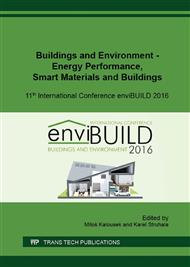p.19
p.24
p.32
p.40
p.48
p.56
p.64
p.72
p.80
Analysis of Unreinforced Ceramic Wall Panels in the Mounting State
Abstract:
Properties of building materials used for the construction of surrounding structures significantly contribute to creating a healthy and comfortable microclimate inside the rooms. Ceramics belong among materials which exhibit very suitable properties for the formation of the healthy environment. It is also one of the reasons that the fired clay structures remain popular among builders and that recovery of ceramic prefabrication can be seen in the Czech Republic. The important step towards rediscovering the benefits of the prefabricated ceramic elements is forthcoming production of unreinforced ceramic wall panels made of fired clay masonry units with tongue and groove, connected in the bed joints by two-component adhesives. Conventional analytical model for vertical loads is used in the operating state. However, in the transport and mounting state it is a structure stressed by bending in its own plane. This paper is focused on the issue of load-bearing capacity of structures with masonry units cross-sections that are not filled in head joints and therefore are unable to transfer either tensile or compressive stresses. On the segment of the wall panel is performed numerical model analysis using the finite element method in the computing program ANSYS and comparison of this analysis results with the results of the experimental tests.
Info:
Periodical:
Pages:
48-55
Citation:
Online since:
December 2016
Authors:
Price:
Сopyright:
© 2017 Trans Tech Publications Ltd. All Rights Reserved
Share:
Citation:


